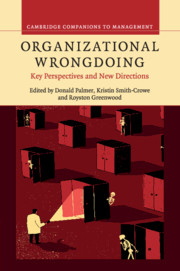Book contents
- Frontmatter
- Contents
- List of figures
- List of tables
- List of contributors
- Foreword
- 1 The imbalances and limitations of theory and research on organizational wrongdoing
- 2 On taking the theoretical substance of outcomes seriously: a meta-conversation
- 3 Wrong paths to right: defining morality with or without a clear red line
- 4 From market enablers to market participants: redefining organizational and political-legal arrangements and opportunities for financial wrongdoing,1930s–2000
- 5 Wrongdoing and market development: an examination of the distinct roles of trust and distrust
- 6 Bad apples, bad barrels and bad cellars: a “boundaries” perspective on professional misconduct
- 7 S/he blinded me with science: the sociology of scientific misconduct
- 8 Social networks and organizational wrongdoing in context
- 9 Falling stars: celebrity, infamy, and the fall from (and return to) grace
- 10 Compensation and employee misconduct: the inseparability of productive and counterproductive behavior in firms
- 11 Beware of organizational saints: how a moral self-concept may foster immoral behavior
- 12 “Is it me? Or is it me?” The role of coactivated multiple identities and identifications in promoting or discouraging workplace crimes
- 13 Consequences of organizational misconduct: too much and too little punishment
- 14 Who bears the brunt? A review and research agenda for the consequences of organizational wrongdoing for individuals
- 15 Organizational wrongdoing and media bias
- 16 Ethical learning: releasing the moral unicorn
- Index
- References
11 - Beware of organizational saints: how a moral self-concept may foster immoral behavior
Published online by Cambridge University Press: 05 July 2016
- Frontmatter
- Contents
- List of figures
- List of tables
- List of contributors
- Foreword
- 1 The imbalances and limitations of theory and research on organizational wrongdoing
- 2 On taking the theoretical substance of outcomes seriously: a meta-conversation
- 3 Wrong paths to right: defining morality with or without a clear red line
- 4 From market enablers to market participants: redefining organizational and political-legal arrangements and opportunities for financial wrongdoing,1930s–2000
- 5 Wrongdoing and market development: an examination of the distinct roles of trust and distrust
- 6 Bad apples, bad barrels and bad cellars: a “boundaries” perspective on professional misconduct
- 7 S/he blinded me with science: the sociology of scientific misconduct
- 8 Social networks and organizational wrongdoing in context
- 9 Falling stars: celebrity, infamy, and the fall from (and return to) grace
- 10 Compensation and employee misconduct: the inseparability of productive and counterproductive behavior in firms
- 11 Beware of organizational saints: how a moral self-concept may foster immoral behavior
- 12 “Is it me? Or is it me?” The role of coactivated multiple identities and identifications in promoting or discouraging workplace crimes
- 13 Consequences of organizational misconduct: too much and too little punishment
- 14 Who bears the brunt? A review and research agenda for the consequences of organizational wrongdoing for individuals
- 15 Organizational wrongdoing and media bias
- 16 Ethical learning: releasing the moral unicorn
- Index
- References
Summary
The road to hell is paved with good intentions.
– an often-heard proverbOrganizational sinners – be they “bad apple” individuals or “bad barrel” organizations (Kish-Gephart, Harrison, and Treviño 2010; Treviño and Youngblood 1990) – are hugely problematic for society, exploiting our faith in actors to do the right thing, to respect norms, and to play not only by the letter of the rules but also by the spirit of ethics. However, as devastating as the actions of bad apples and bad barrels are, the silver lining is that society tends to condemn such actors and that, once identified, they can be rooted out.
But what about “organizational saints,” the purported good apples and good barrels that society lauds? To be sure, research on such individual-level constructs as moral development and moral identity (Rest 1986; Shao, Aquino, and Freeman 2008) and on such organizational-level constructs as ethical infrastructure and corporate social responsibility (Aguinis and Glavas 2012; Tenbrunsel and Smith-Crowe 2008) suggests that good actors do tend to do good things. Unfortunately, there are also disturbing hints that a moral self-concept – an actor's self-perception of being ethical – can sometimes paradoxically foster immoral behavior. For current purposes, we are defining immoral behavior simply as self-interested behavior that intentionally or unintentionally harms others (e.g., causes them pain and suffering, is unfair to them, treats them with disrespect; Haidt and Bjorklund 2008) in a way that generally would be considered unjustified and inappropriate by third-party observers.
As examples of how a moral self-concept might foster immoral behavior, research suggests that actors are adept at licensing themselves to engage in bad behaviors to the extent they see themselves as generally good (Klotz and Bolino 2013; Merritt, Effron, and Monin 2010), and that a strongly held set of moral convictions may lead actors to pursue preferred ends via means that are considered by others to be harmful (e.g., “tree-spiking,” a practice meant to discourage logging and save old-growth forests, but which presents real danger to loggers, has been attributed to the organization Earth First!; Elsbach and Sutton 1992). What is implied by these and other examples that we will draw on here is that a moral self-concept may have a dark side, that “morality is a double-edged sword” (Skitka and Morgan 2009: 370).
- Type
- Chapter
- Information
- Organizational WrongdoingKey Perspectives and New Directions, pp. 305 - 336Publisher: Cambridge University PressPrint publication year: 2016
References
- 14
- Cited by



